On February 6, the southeastern provinces of Turkey were hit by earthquakes that killed more than 40,000 people in Turkey and Syria. This assessment, far from being definitive, could double according to the United Nations. Millions of people are in humanitarian distress as medical personnel struggle to prevent the spread of disease in centers hosting tens of thousands of refugees.
The impact of the disaster on the Turkish economy remains very uncertain, but the amount needed for reconstruction is already estimated between 50 and 85 billion dollars (according to the Turkish Enterprise and Business Confederation).
A state of emergency has been declared for 11 cities. Among them are Kahramanmaraş, Hatay and Gaziantep, which are key regional logistics, production and export hubs. These regions produce approximately 12% of the country’s GDP and represent approximately 20% of agricultural and forestry production, 10% of manufacturing production, and nearly 15% of construction activity.
While inflation is already very high (58%), the loss of agricultural production and the start of Ramadan in March should amplify the phenomenon. Coface thus estimates that inflation will average 50% in 2023, whereas it had reached 72% in 2022.
In the short term, growth should slow down sharply.
During the earthquake in 1999, GDP contracted by 3.3% before rebounding by 6.8% in 2000. Coface had estimated at the start of the year that GDP would grow by 3.5% in 2023, a figure which does not take into account the effects of the earthquake which remain to be specified.
Indeed, factories have been totally or partially destroyed. The Turkish banking supervisory body (BDDK) has also put in place initial mechanisms to ease certain debt constraints and allow impacted companies to compensate for part of their losses and the deterioration of their cash flow. .
According to COFACE’s analyses, the sectors most affected by the disaster are textiles and clothing, retail trade, agri-food, services, information and communication technologies, metals, and chemistry.
In the medium term, the need to rebuild an area estimated at 110,000 square km (therefore larger than Denmark, the Netherlands, Switzerland or even Belgium) and populated by 13 million inhabitants could support the building.
President Erdogan has thus declared that the construction of 30,000 residential buildings in the earthquake zone will begin in March.
On the political level, the consequences of the earthquake, combined with the economic turbulence of 2022 (historically high inflation, weakness of the Turkish lira, etc.), could lead the population, who will be called upon to vote in elections on May 14 , to focus on the domestic economic situation of the country.
There is however a debate on the fact that these elections can be held: the opposition asks that they be maintained and there is great uncertainty in the matter.
Source: COFACE








Réagissez à cet article